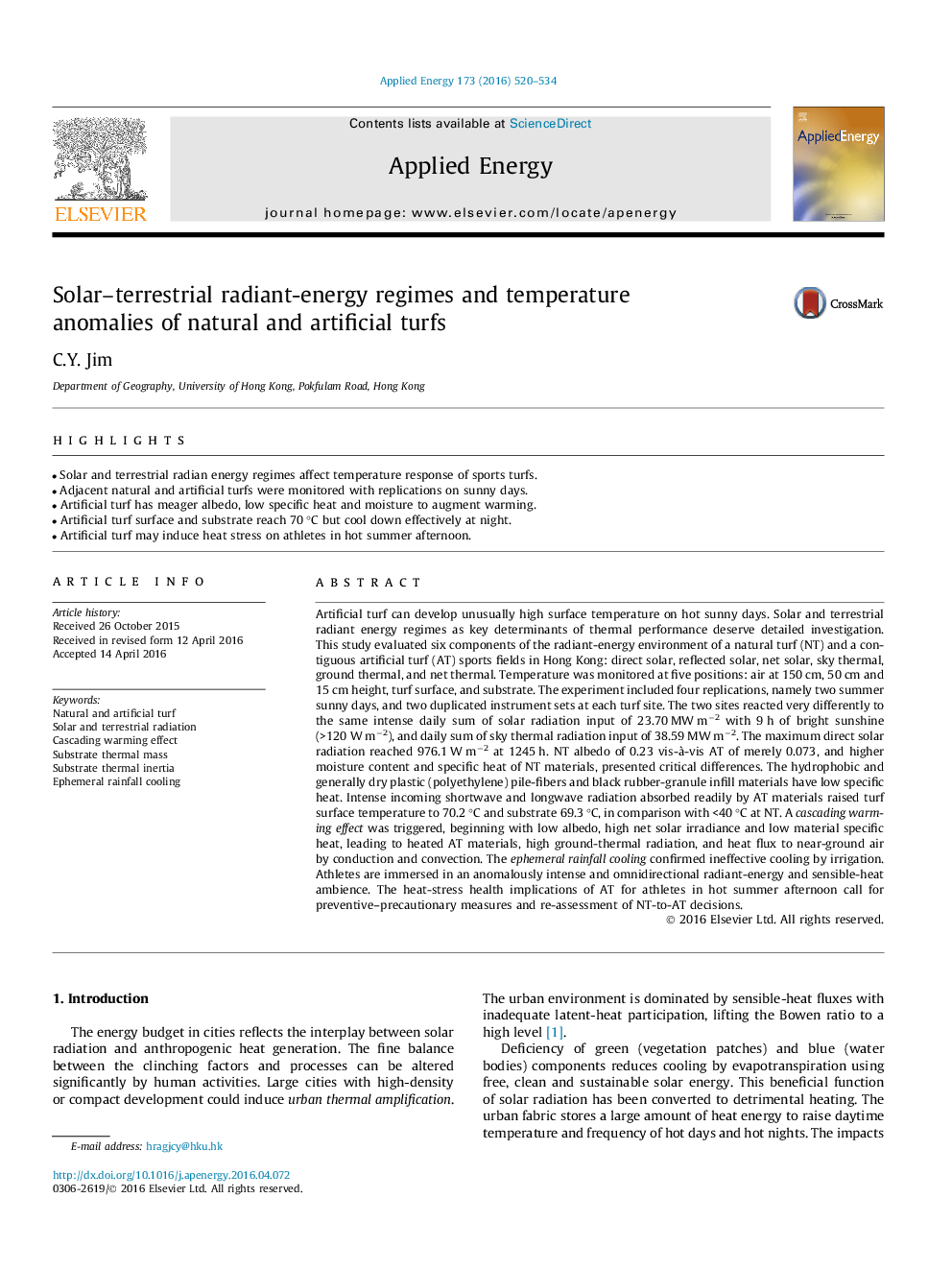| کد مقاله | کد نشریه | سال انتشار | مقاله انگلیسی | نسخه تمام متن |
|---|---|---|---|---|
| 6683205 | 501853 | 2017 | 15 صفحه PDF | دانلود رایگان |
عنوان انگلیسی مقاله ISI
Solar-terrestrial radiant-energy regimes and temperature anomalies of natural and artificial turfs
ترجمه فارسی عنوان
رژیم های انرژی تابشی خورشیدی و زمین و ناهنجاری های دمای چاه های طبیعی و مصنوعی
دانلود مقاله + سفارش ترجمه
دانلود مقاله ISI انگلیسی
رایگان برای ایرانیان
کلمات کلیدی
چمن طبیعی و مصنوعی، تابش خورشیدی و زمین، اثر گرمایش کاسکواد، جرم حرارتی پایه، اینرسی حرارتی پایه، خنک کننده باران صبحگاهی
موضوعات مرتبط
مهندسی و علوم پایه
مهندسی انرژی
مهندسی انرژی و فناوری های برق
چکیده انگلیسی
Artificial turf can develop unusually high surface temperature on hot sunny days. Solar and terrestrial radiant energy regimes as key determinants of thermal performance deserve detailed investigation. This study evaluated six components of the radiant-energy environment of a natural turf (NT) and a contiguous artificial turf (AT) sports fields in Hong Kong: direct solar, reflected solar, net solar, sky thermal, ground thermal, and net thermal. Temperature was monitored at five positions: air at 150 cm, 50 cm and 15 cm height, turf surface, and substrate. The experiment included four replications, namely two summer sunny days, and two duplicated instrument sets at each turf site. The two sites reacted very differently to the same intense daily sum of solar radiation input of 23.70 MW mâ2 with 9 h of bright sunshine (>120 W mâ2), and daily sum of sky thermal radiation input of 38.59 MW mâ2. The maximum direct solar radiation reached 976.1 W mâ2 at 1245 h. NT albedo of 0.23 vis-à -vis AT of merely 0.073, and higher moisture content and specific heat of NT materials, presented critical differences. The hydrophobic and generally dry plastic (polyethylene) pile-fibers and black rubber-granule infill materials have low specific heat. Intense incoming shortwave and longwave radiation absorbed readily by AT materials raised turf surface temperature to 70.2 °C and substrate 69.3 °C, in comparison with <40 °C at NT. A cascading warming effect was triggered, beginning with low albedo, high net solar irradiance and low material specific heat, leading to heated AT materials, high ground-thermal radiation, and heat flux to near-ground air by conduction and convection. The ephemeral rainfall cooling confirmed ineffective cooling by irrigation. Athletes are immersed in an anomalously intense and omnidirectional radiant-energy and sensible-heat ambience. The heat-stress health implications of AT for athletes in hot summer afternoon call for preventive-precautionary measures and re-assessment of NT-to-AT decisions.
ناشر
Database: Elsevier - ScienceDirect (ساینس دایرکت)
Journal: Applied Energy - Brought to you by:GAYATRI VIDYA PARISHAD COLLEGE OF ENGINEERING for Women due by 31 Dec 2017
Journal: Applied Energy - Brought to you by:GAYATRI VIDYA PARISHAD COLLEGE OF ENGINEERING for Women due by 31 Dec 2017
نویسندگان
C.Y. Jim,
